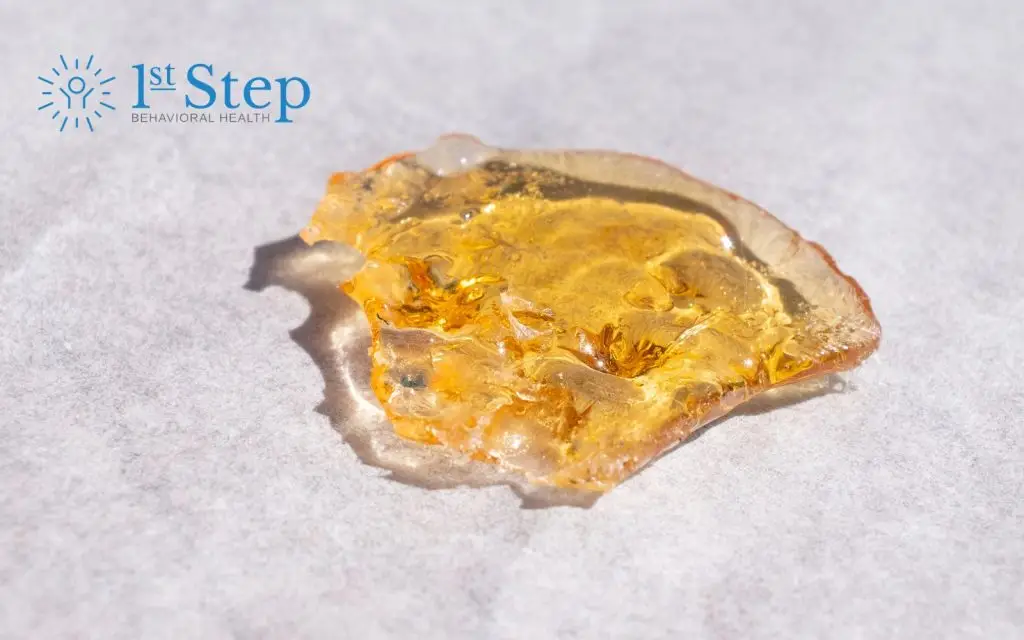Marijuana is a plant that people smoke to experience a euphoric and calming high. The active ingredient in marijuana is tetrahydrocannabinol (THC). While this substance is legal for medicinal and recreational use in many states, abusing it can still lead to addiction.
According to the National Institute of Drug Abuse (NIDA), “Among people aged 12 or older in 2021, 18.7% (or about 52.5 million people) reported using cannabis in the past 12 months.”[1]
There are several different types of THC products, from edibles and vape pens to wax and even a substance known as shatter. Every type of THC can provide a different potency level to its users.
One of the most potent forms of THC is shatter.
How is Shatter Made?
Shatter is a type of marijuana concentrate that is also known as butane hash oil (BHO). It is referred to as BHO because butane is used to extract cannabinoids and terpenes from the marijuana plant.[2] The result of this extraction process is an incredibly potent, highly concentrated version of cannabis. It has a longer shelf-life than other cannabis products, so it can be stored for extended periods of time.
When shatter is created, marijuana buds and other cannabis plant material are soaked in butane and trimmed to separate trichomes from the plant. Then the substance is heated to remove as much butane as possible. However, there will still be leftover butane inside of the shatter, which means people who smoke it are also consuming butane.
Once the shatter is cooled, it has a gold or amber color and resembles a thick shard of glass or piece of rock candy. Some people compare the color of shatter to honey or maple syrup. When people use the substance, it is broken up or “shattered” into smaller pieces.
What is the Difference Between Shatter and Wax?
Wax is a product with high concentrations of THC that resembles earwax. Some types of wax appear more closely to yellow-colored butter and have a creamy texture. Wax is created using a similar process as shatter.
While wax and shatter are closely related, there are some key differences to be aware of, such as:
- The process of creating shatter is a little bit more complex
- Shatter lasts longer on the shelf
- Wax is easier to manage and use due to its consistency
Both wax and shatter are highly potent marijuana extracts. Anyone using either of these drugs should use caution. Taking too much shatter or wax at once could lead to undesirable side effects, such as heart palpitations and even psychosis.
The Effects of Shatter
Shatter is a more potent form of marijuana, which means you get a higher concentration of THC when you use it and a stronger high than regular marijuana. As a result, individuals who abuse shatter must use caution to prevent negative side effects.
Potential effects of shatter may include:[3]
- Relaxation
- A rush of euphoria
- Reduced nausea
- Changes in heart rate and blood pressure
- Sore throat
- Bloodshot eyes
- Increased appetite
- Anxiety and panic
- Decreased reaction time
- Inability to pay attention
- Confusion and paranoia
- Detachment from reality
Is Shatter Dangerous?
Shatter or butane hash oil has not been extensively researched. As a result, it can be difficult to determine how dangerous it is in the long term.
However, it is not healthy to continually inhale large amounts of solvents like butane. Each batch of shatter that is made could contain varying amounts of butane. If you get a batch that contains too much butane, smoking it can be lethal.
It is important to note that in most cases, shatter bought from a recreational or medicinal dispensary will not contain lethal amounts of butane because it is regulated. Unfortunately, buying shatter off of the street can be dangerous.
In addition to the risk of consuming too much butane, you could develop THC-induced psychosis. When you consume shatter, you are inhaling large amounts of THC at once, so you are more likely to experience an intense high and unwanted side effects like psychosis than when using the traditional form of cannabis flower.
According to the Yale School of Medicine, “Studies have shown that THC in cannabis can cause short-term psychosis until the drug is metabolized in the body.”[4]
Shatter Dependence and Addiction
Cannabis concentrates like shatter can be highly addictive due to how potent they are. The intense high makes it more likely for users to develop a tolerance quickly. As tolerance builds, individuals may find themselves needing more of the substance to achieve the same effects, which can lead to a cycle of abuse and dependence.
Signs of cannabis use disorder (addiction) include:
- Increased frequency of use, often daily or multiple times a day.
- Using shatter despite experiencing negative physical or mental health effects.
- Prioritizing cannabis extract use over responsibilities, relationships, or activities.
- Inability to reduce or control use, despite wanting to cut back.
When someone who is dependent on shatter stops using it, they may experience withdrawal symptoms. These symptoms occur because the body has become accustomed to the high levels of THC, and without it, the brain’s chemical balance is disrupted. Withdrawal from shatter can be particularly challenging due to its potency and the body’s adaptation to the high THC content.
Common withdrawal symptoms include:
- Irritability and mood swings
- Anxiety and depression
- Insomnia or disrupted sleep patterns
- Loss of appetite
- Intense cravings for the drug
- Physical symptoms such as headaches, nausea, and sweating
Treatment for cannabis addiction often includes a combination of medical supervision, counseling, and support groups to address both the physical and psychological aspects of dependence.
Find Help for Marijuana Abuse and Addiction
If you or a loved one regularly consume shatter, you could be suffering from an addiction. Many people believe that marijuana is not addictive, but you can develop an addiction to all types of marijuana, from edibles and buds to wax and shatter.
At First Step Behavioral Health, we can provide you with the support and tools you need to maintain long-term sobriety. Contact us today to learn more about our marijuana addiction treatment programs.
References:
- The National Institute of Drug Abuse (NIDA): What is the scope of cannabis use in the United States, Retrieved August 2023 From https://nida.nih.gov/publications/research-reports/marijuana/what-scope-marijuana-use-in-united-states
- The National Library of Medicine (NLM): Butane hash oil and dabbing: insights into use, amateur production techniques, and potential harm mitigation, Retrieved August 2023 From https://www.ncbi.nlm.nih.gov/pmc/articles/PMC6220730/
- The Alcohol and Drug Foundation (ADF): Butane Hash Oil, Retrieved August 2023 From https://adf.org.au/drug-facts/butane-hash-oil/
- Yale School of Medicine: Cannabis Use and Psychosis, Retrieved August 2023 From https://medicine.yale.edu/psychiatry/step/early-intervention-services/cannabis%20use%20and%20psychosis_380524_284_53825_v2.pdf
Jump to a Section
Call (855) 425-4846
